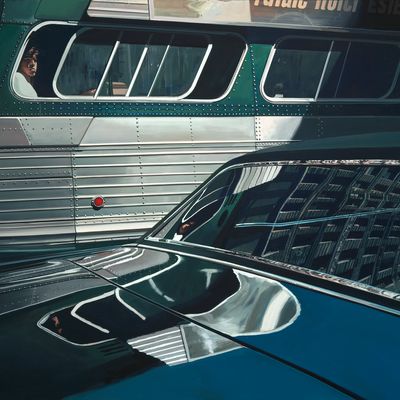
Whenever I return from a trip out of town, New York seems to have acquired a hallucinatory sharpness in my absence. The city contains more facets per square inch, more bricks, signs, people, and windows than wherever I have just been. It’s as if I am suddenly seeing the city through upgraded glasses, or by the light of a brighter bulb. That visual tingle returned to me recently, at the Richard Estes retrospective that is now living out its final days at the Museum of Arts and Design. (It closes on September 20.) His photo-realist paintings of New York (mostly Manhattan, a little Brooklyn) brim with astoundingly minute detail. Estes dwells on roughened façades, on the bleached light of a hot summer day, on the archaeological traces of sidewalk litter. Humans populate his panoramas like creatures spotted on safari — startling presences, but a little distant and unreal. His subject is the city itself. Skyscrapers preen against cloudless backdrops. Sidewalks and shop windows perform a disorienting counterpoint of reflections.
It is easy to look at a reproduction of an Estes painting and mistake it for a photo, or to dismiss it as a slavish paint-by-numbers copy from another genre. In the flesh, though, it resolves into a tour de force of subtle invention. The show juxtaposes his finished works with the photo collages he made in lieu of sketches. You can see the way he moved obstacles and sharpened shadows. The skyline looms a little closer. Daylight acquires the dramatic vividness of a dream. A man in a gray T-shirt and jeans sits next to himself on a southbound bus near the Plaza Hotel, and one version turns to look out the window while the other stares straight ahead, so we don’t notice the doubling at first.
Estes’s New York is a state of extreme alertness, engraving each observed moment into memory. The artist seems keenly aware that by the time the oil dries on the canvas, the city will have changed again. In Sunday Afternoon in the Park, a couple stretches out like sea lions on a boulder in Central Park, with the 1989 skyline rising in the distance — but rising much less than it does today. There’s no Time Warner Center, no skinny apartment towers along 57th Street. The Gulf & Western Building at Columbus Circle hasn’t yet acquired its Trump-y coating of mirrored glass. Estes painted the scene with such dazzling specificity that it reads like a message tossed down through the decades: This is how it was.
Of course any artless snapshot starts its journey into nostalgia just as soon as the shutter clicks. The photographer can’t know which details will look antique a generation hence, or what will make a descendant smile with recognition. But Estes doesn’t have to wait. He heightens the drama of loss. He animates the city, making it eloquent, turning it from a backdrop into a character.
In 1975, Estes painted a watercolor of Union Square, Looking North. A grey expanse of asphalt stretches toward the park, which is ringed by glowering trees and framed by a mansarded roof (now the W Hotel) and the MetLife tower at Madison Square. A row of big-bodied ’70s gas-guzzlers noses in toward the curb, as if praying to the equestrian statue of Washington. Below the painting, a photograph, roughly sliced into eight segments, shows the same panorama, except that the camera’s version is drab. It takes a while to ferret out Estes’s tweaks. He’s deleted a construction fence, a traffic sign, a lamppost, and a passerby, deftly uncluttering the view. He’s also darkened the sky and thickened the foliage, giving the scene a slightly bluish, stormy light. In the painting, white traffic stripes shoot toward the corner of the frame, exaggerating the perspective. In the photograph, they swing harmlessly away, exiting right. Estes manipulates reality with such dexterity that he makes the original seem like a distant echo of the New York that blazes in his dreams. In his world, the people seem interchangeable or permanent, while the buildings keep evolving all around.
These distortions make Estes’s paintings feel true to the experience of living here, of watching people settle in and leave, of watching the streetscape get constantly deconstructed and rebuilt. In several works, he divides the frame in half, with the inside of a bus or subway car on one side and the view out the window on the other. Those works reinforce my sense of the city as a collection of glass cases, in which it can be hard to tell the observers from the observed. When Estes shows the skyline liquefying in reflection on the hood of a car, he literalizes the sensation of a city in constant flux. At times, the view of a storefront explodes into layered reflections, so that the rusticated façade of a building across the street merges with the window display and the lit interior. Then, space appears to flatten into a single kaleidoscopic plane: the urban phantasmagoria. Estes’s best work quivers with the sense that New Yorkers inhabit a cityscape not just of concrete and steel but of powerful memory and vivid illusions.





